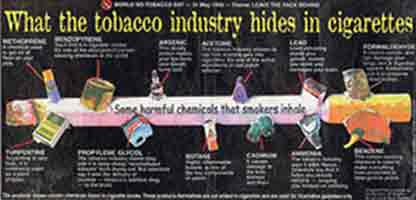2000-2004:
REGIONAL ACTION PLAN ON TOBACCO OR HEALTH
WORLD HEALTH ORGANIZATION, WESTERN PACIFIC REGION
|
to
CONTENTS |
| "The future is not
a result of choice among alternative paths offered by the present,
but a place that is created, first in the mind, next in the will
then in activity. The future is not some place where we are going
to, but a place we are creating. The paths are not to be discovered,
but made; and the activity of making the future changes both the
maker and the destination."
John Schaar
|
PREFACE
WHO, working in partnership with Member States and others, is committed
to controlling the global tobacco epidemic, particularly in the Asia-Pacific
region where it is most rampant. The overall aim of the Action Plan on
Tobacco or Health, 2000-2004 is to achieve a measurable and sustainable
reduction in smoking prevalence rates. It is intended to encourage and
support Member States in their efforts to grapple with this major public
health issue.
This Action Plan has been developed in the context of the theme on "Building
healthy communities and populations" at the WHO Regional Office for
the Western Pacific. It reflects the regional activities being carried
out under the focus on the Tobacco Free Initiative.

MISSION STATEMENT
The long-term mission of the Tobacco Free Initiative in the Western Pacific
Region is to reduce the burden of disease and death caused by tobacco
through achieving a measurable and sustainable reduction in smoking prevalence
rates and tobacco consumption in all countries and among all groups in
the Western Pacific Region.
In support of this mission, the overall global goals of the Tobacco Free
Initiative are to:
- Galvanize regional support for evidence-based tobacco control policies
and actions.
- Build new and strengthen existing partnerships for action.
- Heighten awareness of the need to address the tobacco problem at
all levels of society.
- Accelerate national, regional and global implementation of measures
to reduce tobacco consumption.
- Commission research to support rapid, sustained and innovative actions.
- Mobilize resources to support required actions.

OBJECTIVES
- To deter and control tobacco use and to reduce smoking prevalence
rates.
- To deter the onset of tobacco use, particularly among adolescents
and women.
- To motivate and support people to quit tobacco use.
TARGETS
- To have National plans of Action for Tobacco Control in place in
all Member States by the end of 2001.
- To have effective policies to deter and control tobacco use in place
in all Member States by the end of 2002; and effective legislation
and regulations in place by the end of 2003.
- To develop and be using advocacy, educational and promotional campaigns
and materials appropriate to the Region as a whole by the end of 1999;
and appropriate to each country by the end of 2001.
- In conjunction with the development and implementation of the Regional
and National Plans of Action, to include specific indicators of progress
that are consistent with available data, and indicators that are based
on the development of appropriate new data.
STRATEGIES
In accomplishing the objectives of this strategic plan, the following
strategies will be used:
- Develop and implement National Plans of Action for Tobacco Control.
- Develop and implement policies, legislation and regulations that
deter tobacco use, including those that affect pricing and marketing;
advertising and promotional activities; and smoking in public places.
- Develop and use advocacy, educational and promotional campaigns
and materials that encourage people not to start or to quit smoking;
and support the development and adoption of the international Framework
Convention on Tobacco Control.
- Monitor and evaluate the effectiveness of the Regional Tobacco Free
Initiative.
EXPECTED RESULTS
2000 - 2001
 |
National Plans of Action
- All countries should have at least one full-time member of
staff, or equivalent, devoted to tobacco or health issues.
- All countries should have developed National Plans of Action,
with annual reporting on implementation by the TOH focal person.
- Best-practice health education, promotion and advocacy approaches
should be used.
- Focal persons should actively coordinate with NGOs.
- There should be evidence of active support for the international
Framework Convention on Tobacco Control (FCTC).
Policies, legislation and regulations that deter tobacco use
- All countries should have adopted a policy to deter tobacco
use.
- All countries should have initiated consultation on and drafting
of legislation, including endorsement from medical organizations
and health-related nongovernmental organizations (NGOs).
- All medical and allied health training institutions should
be smoke-free.
Advocacy, educational and promotional campaigns and materials
- A mass media strategy should have been developed as an integral
part of the National Plan.
- Advocacy to support the development and dissemination of the
policy component of the National Plan should be carried out
regularly.
- Medical associations and allied health professionals should
have endorsed a strong policy statement on the health implications
of tobacco smoke.
- All schools should be smoke-free and TOH issues should be
reflected in the curriculum.
- Resources should have been adapted and developed in the context
of existing programmes, projects and strategies, to ensure linkages
with and complementarity among tobacco-related initiatives (e.g.
noncommunicable diseases and Healthy Settings).
Research, monitoring and evaluation
- A strategy should have been developed (and implementation
initiated) to collect all the data required for economic evaluation
of the impact of the National Plan.
- A research and evaluation strategy should have been developed
for monitoring the impact of all tobacco control activities.
- The capacity to use existing health data to assess impacts
of tobacco on health should have been developed.
|
2002 - 2003
 |
National Plans of Action
- There should be ongoing implementation and evaluation of National
Plans of Action
Policies, legislation and regulations that deter tobacco use
- Regulations should have been developed in the following core
areas:
- restrictions on all forms of advertising and promotion;
- strong and prominent health warnings on all tobacco products;
- restrictions on smoking in public places, schools and
workplaces;
- taxation increases with significant portion of related
revenue dedicated to tobacco control, where feasible;
- controls over smuggling; and
- provision for funding and enforcement where required.
- The infrastructure for implementation is in place.
- A plan should have been developed for progressively phasing
in and phasing out of legislation and regulations, as appropriate.
- A plan should have been developed for controlling indirect
advertising.

Advocacy, educational and promotional campaigns and materials
- A mass media campaign should have been implemented, with particular
emphasis on legislators and the FCTC.
- Specific smoking cessation initiatives (e.g."quitlines" and
cessation clinics) should be in place.
- Targeted strategies developed for hard-to-reach and priority
groups should have been formulated.
Research, monitoring and evaluation
- An economic evaluation of the National Plan should have been
carried out and the information disseminated to target audiences
(e.g. policy-makers and other stakeholders).
- There should be ongoing monitoring of Plan implementation,
smoking (tobacco consumption) prevalence, and smoking restrictions
(e.g. in public places and workplaces).
- An assessment of environmental impacts of tobacco use (e.g.
fires and deforestation) should have been carried out.
|
|






